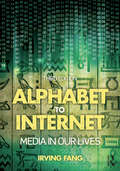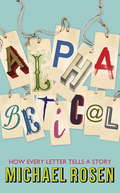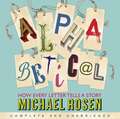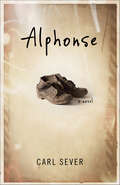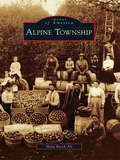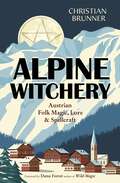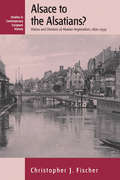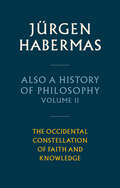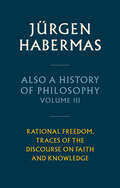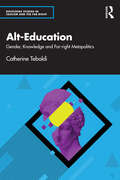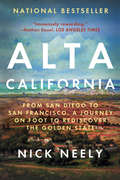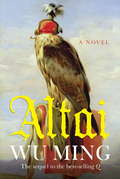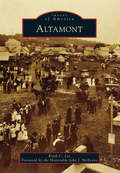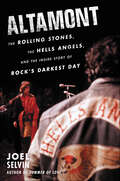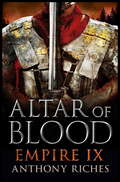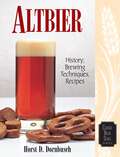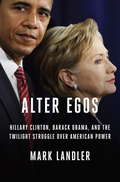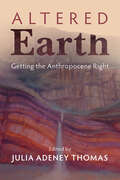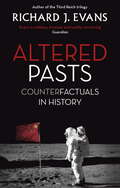- Table View
- List View
Alphabet to Internet: Media in Our Lives
by Irving FangWhat Greek philosopher thought writing would harm a student’s memory? Was the poet Byron’s daughter the first computer programmer? Who plays more video games, women over 18 or teenage boys? In Alphabet to Internet: Media in Our Lives, Irving Fang looks at each medium of communication through the centuries, asking not only, "What happened?" but also, "How did society change because of this new communication medium?" and, "How are we different as a result?" Examining the impact of different media on a broad, historical scale—among them mass printing, the telegraph, film, the internet, and advertising—Alphabet to Internet takes us from the first scratches of writing and the origins of mail to today's video games, the widespread and daily use of smartphones, and the impact of social media in political uprisings across the globe. A timeline at the end of each chapter places events in perspective and allows students to pinpoint key moments in media history. Now in its third edition, Alphabet to Internet presents a lively, thoughtful, and accessible introduction to media history.
Alphabetical: How Every Letter Tells a Story
by Michael RosenFrom minding your Ps and Qs to wondering why X should mark the spot, Alphabetical is a book for everyone who loves words and language. Whether it's how letters are arranged on keyboards or Viking runes, textspeak or zip codes, this book will change the way you think about letters for ever. How on Earth did we fix upon our twenty-six letters, what do they really mean, and how did we come to write them down in the first place? Michael Rosen takes you on an unforgettable adventure through the history of the alphabet in twenty-six vivid chapters, fizzing with personal anecdotes and fascinating facts. Starting with the mysterious Phoenicians and how sounds first came to be written down, he races on to show how nonsense poems work, pins down the strange story of OK, traces our seven lost letters and tackles the tyranny of spelling, among many, many other things. His heroes of the alphabet range from Edward Lear to Phyllis Pearsall (the inventor of the A-Z), and from the two scribes of Beowulf to rappers. Each chapter takes on a different subject - codes, umlauts or the writing of dictionaries. Rosen's enthusiasm for letters positively leaps off the page, whether it's the story of his life told through the typewriters he's owned or a chapter on jokes written in a string of gags and word games. So if you ever wondered why Hawaiian only has a thirteen-letter alphabet or how exactly to write down the sound of a wild raspberry, read on . . .
Alphabetical: How Every Letter Tells a Story
by Michael RosenFrom minding your Ps and Qs to wondering why X should mark the spot, Alphabetical is a book for everyone who loves words and language. Whether it's how letters are arranged on keyboards or Viking runes, textspeak or zip codes, this book will change the way you think about letters for ever. How on Earth did we fix upon our twenty-six letters, what do they really mean, and how did we come to write them down in the first place? Michael Rosen takes you on an unforgettable adventure through the history of the alphabet in twenty-six vivid chapters, fizzing with personal anecdotes and fascinating facts. Starting with the mysterious Phoenicians and how sounds first came to be written down, he races on to show how nonsense poems work, pins down the strange story of OK, traces our seven lost letters and tackles the tyranny of spelling, among many, many other things. His heroes of the alphabet range from Edward Lear to Phyllis Pearsall (the inventor of the A-Z), and from the two scribes of Beowulf to rappers. Each chapter takes on a different subject - codes, umlauts or the writing of dictionaries. Rosen's enthusiasm for letters positively leaps off the page, whether it's the story of his life told through the typewriters he's owned or a chapter on jokes written in a string of gags and word games. So if you ever wondered why Hawaiian only has a thirteen-letter alphabet or how exactly to write down the sound of a wild raspberry, read on . . .
Alphabetical: How Every Letter Tells a Story
by Michael RosenFrom minding your Ps and Qs to wondering why X should mark the spot, Alphabetical is a book for everyone who loves words and language. Whether it's how letters are arranged on keyboards or Viking runes, textspeak or zip codes, this book will change the way you think about letters for ever. How on Earth did we fix upon our twenty-six letters, what do they really mean, and how did we come to write them down in the first place? Michael Rosen takes you on an unforgettable adventure through the history of the alphabet in twenty-six vivid chapters, fizzing with personal anecdotes and fascinating facts. Starting with the mysterious Phoenicians and how sounds first came to be written down, he races on to show how nonsense poems work, pins down the strange story of OK, traces our seven lost letters and tackles the tyranny of spelling, among many, many other things. His heroes of the alphabet range from Edward Lear to Phyllis Pearsall (the inventor of the A-Z), and from the two scribes of Beowulf to rappers. Each chapter takes on a different subject - whether it's codes, umlauts or the writing of dictionaries. Rosen's enthusiasm for letters positively leaps off the page, whether it's the story of his life told through the typewriters he's owned or a chapter on jokes written in a string of gags and word games. So if you ever wondered why Hawaiian only has a thirteen-letter alphabet, why X should mark the spot or became shorthand for Christmas or how exactly to write down the sound of a wild raspberry, read on . . .(P)2013 Hodder & Stoughton
Alphonse: A Novel
by Carl SeverAfter twenty years of riding the rails, Alphonse has earned a reputation for being a kindhearted soul always ready to help. When he helps the Sadlers, a young couple seeking a better life in small-town 1950s Indiana, he doesn’t intend to stay. But stay he does, keeping a close eye on the Sadlers and their two young sons—and an even closer eye on the town’s new priest, Father Brennon. On the surface, Brennon seems perfect for the job—but Alphonse crossed paths with him years earlier in the railyard jungle, and he knows better. Brennon doesn’t recognize Alphonse, but Alphonse has never forgotten Brennon . . . or his crimes. So when Brennon assigns the Sadlers’ son, Francis, who is now thirteen, the thankless task of cleaning and maintaining the church’s bell tower—work that often continues into the night—Alphonse immediately grows suspicious. Soon, he discovers that his worst fears have come to pass, and he races to find a way to protect Francis and reveal the truth to the Sadler family.
Alpine Township (Images of America)
by Mary Rasch AltAlpine Township's roots are in harvesting. Native Americans harvested cranberries near a lake by the same name, Cranberry Lake. After logging out the forested area of the township, starting 160 years ago, farmers found peach trees, then apples, and a variety of fruit grew well on the rolling hills of this area referred to as "the Ridge." The name Alpine came from the combination of two words, all pine, in reference to the trees that grew in abundance in the township. Today Alpine Avenue has become a major commercial district on the northwest side of Grand Rapids, in western Michigan.
Alpine Witchery: Austrian Folk Magic, Lore & Spellcraft
by Danu Forest Christian BrunnerExperience the Austrian Witch Trials through Authentic Stories and SpellsUncover a hidden world of European folk magic preserved within trial documents from the Austrian Alps. Christian Brunner reveals nearly fifty spells and the captivating stories behind them, offering a rare glimpse into the lives of the accused. He also teaches you how to adapt these workings for your own modern practice.Explore translated testimonies and enchantments originally recorded between the Renaissance and the Age of Enlightenment, a time before the Brothers Grimm standardized German grammar. Using the defendants’ and witnesses’ own words, Brunner paints a vivid picture of Alpine witchcraft, including the pressures, tensions, and influences of the times.With riveting details about the witch trials and advice for making historic Alpine spells your own, this is an essential resource for those seeking to connect with the past and harness its wisdom.
Alsace To The Alsatians?
by Christopher J. FischerThe region of Alsace, located between the hereditary enemies of France and Germany, served as a trophy of war four times between 1870-1945. With each shift, French and German officials sought to win the allegiance of the local populace. In response to these pressures, Alsatians invoked regionalism--articulated as a political language, a cultural vision, and a community of identity--not only to define and defend their own interests against the nationalist claims of France and Germany, but also to push for social change, defend religious rights, and promote the status of the region within the larger national community. Alsatian regionalism however, was neither unitary nor unifying, as Alsatians themselves were divided politically, socially, and culturally. The author shows that the Janus-faced character of Alsatian regionalism points to the ambiguous role of regional identity in both fostering and inhibiting loyalty to the nation. Finally, the author uses the case of Alsace to explore the traditional designations of French civic nationalism versus German ethnic nationalism and argues for the strong similarities between the two countries' conceptions of nationhood.
Alsip
by Susan L. Bruesch Patrick E. KitchingThe village of Alsip got its name from the area's first big business, Frank Alsip's Brickyard. Although Alsip is now known for its tight-knit neighborhoods and large industrial community, it was not always so. Recorded area history goes back to the 1600s, when a Catholic mission stood at 122nd and Loveland Streets, and the first European settlers began farming the area in the 1800s. The historic farmhouse featured on the front cover was homesteaded by DeWitt and Amy Baxter Lane in 1835. Area maps identified this homestead as "Lanes Island" because it was surrounded by marshy swamps. DeWitt's father, Joseph, opened a smithy along a busy Indian trail that passed by Lanes Island and worked until he died in 1839. The tough-as-nails pioneers featured in Images of America: Alsip drained the swampland, which gave rise to a future of fertile farming, eventually leading to the first Village of Alsip board meeting, held on April 26, 1927.
Also a History of Philosophy, Volume 2: The Occidental Constellation of Faith and Knowledge
by Jürgen HabermasIn this second volume of his groundbreaking new work on the history of philosophy, Jürgen Habermas traces the development of Western thought from the reception of Platonism by early Christian thought, through the revolution in medieval philosophy and theology triggered by the rediscovery of Aristotle’s works, up to the decoupling of philosophical and theological thought in nominalism and the Reformation that ushered in the postmetaphysical thinking of the modern age. In contrast to conventional histories that focus on movements and schools, Habermas takes the dialectic of faith and knowledge as a guiding thread for analysing key developments in the thought of major figures such as Augustine, Aquinas, Scotus, Ockham and Luther that constitute milestones in the genealogy of postmetaphysical thinking. A distinctive feature of Habermas’ approach is the prominence he accords practical philosophy, and in particular legal and political ideas, and the corresponding attention he pays to social, institutional and political history, especially as these bear on the relationship between church and state. As a result, the central preoccupations of Christian thought are shown to be original responses to questions raised by the Christian worldview that exploded the framework of Greek metaphysical thinking and remain crucial for the self-understanding of contemporary philosophy. Far from raising claims to exclusivity, completeness or closure, Habermas’s history of philosophy, published in English in three volumes, opens up new lines of research and reflection that will influence the humanities and social sciences for decades to come.
Also a History of Philosophy, Volume 3: Rational Freedom. Traces of the Discourse on Faith and Knowledge
by Jürgen HabermasIn the final volume of his history of philosophy, Jürgen Habermas offers a series of brilliant interpretations of the thinkers who set the agenda for contemporary philosophy. Beginning with masterful readings of Hume and Kant, he traces the genealogy of their postmetaphysical thinking through the main currents of historicism and German Idealism, and the multifarious reactions to Hegel’s influential system, culminating in nuanced readings of Marx, Kierkegaard and Peirce. Through his analysis of their work, Habermas demonstrates the interpretive fecundity of the central themes of his philosophical enterprise – his pragmatist theory of meaning, his communicative theories of subjectivity and sociality, and his discursive theory of normativity in its moral, juridical and political manifestations. In contrast to the bland compendia of thinkers and positions generally presented in surveys of the history of philosophy, Habermas’s thematically focused interpretations are destined to provoke controversy and stimulate dialogue. With this work one of the indisputably great thinkers of our time presents a powerful vindication of his conception of philosophy as an inherently discursive – and not merely analytical or speculative – enterprise.
Alt-Education: Gender, Knowledge and Far-right Metapolitics (Routledge Studies in Fascism and the Far Right)
by Catherine TebaldiAlt-Education looks at the stories the right tells about schools: a fight between an evil, indoctrinating government and a far-right freethinking truth warrior, between a frigid cultural Marxist teacher and a loving Christian mother.This book explores the link between education, gender, and far-right metapolitics, and offers insights into the ways in which it circulates and is normalized. Through digital ethnography and fieldwork it explores the production, circulation, and interpretation of these discourses and the ideologies they express, tracing their movement across four groups of women in the US and UK – fascists, white nationalist, Christian nationalists, and Republicans. Although often understood to be opposed to education, the far-right is instead opposed to schooling – and offers its own practices of alt-education. Through media, alternative schools and home education, the far-right teaches their ideologies of gender and race, knowledge, and power, as well as transmitting alternative histories, sociologies, and conspiracies. From mom’s groups to digital discourses about the evils of public schools, social media are key arenas in which women not only teach, but are taught, far-right alternative knowledge. Alt-education teaches reactionary ideology as a timeless truth, normalizing it through discourses of home, family and love. At the same time, alt-education borrows and co-opts the language of critique – normalizing racism, sexism and fascism a kind of alternative knowledge, while making it exciting as a countercultural critique of “woke” liberal indoctrination. The book concludes with a look at this attempt to “speak post-truth to power” as a way of normalizing and spreading their ideology – bringing alt-education to a wide audience as their critiques of “woke” politics spreads across the US, UK, and into Europe.This book is aimed at scholars of the far-right and gender, as well as scholars and practitioners of education. Written in an accessible and engaging tone, this book will be of interest to both researchers and advanced undergraduates.
Alta California: From San Diego to San Francisco, A Journey on Foot to Rediscover the Golden State
by Nick NeelyThis national bestseller chronicles one man’s 650–mile trek on foot from San Diego to San Francisco—sure to appeal to readers of naturalist works like Edward Abbey’s Desert Solitaire, Paul Thoreau’s On the Plain of Snakes, and Mark Kenyon’s That Wild Country.In 1769, an expedition led by Gaspar de Portolá sketched a route that would become, in part, the famous El Camino Real. It laid the foundation for the Golden State we know today, a place that remains as mythical and captivating as any in the world.Despite having grown up in California, Nick Neely realized how little he knew about its history. So he set off to learn it bodily, with just a backpack and a tent, trekking through stretches of California both lonely and urban. For twelve weeks, following the journal of expedition missionary Father Juan Crespí, Neely kept pace with the ghosts of the Portolá expedition—nearly 250 years later.Weaving natural and human history, Alta California relives Neely’s adventure, while telling a story of Native cultures and the Spanish missions that soon devastated them, and exploring the evolution of California and its landscape. The result is a collage of historical and contemporary California, of lyricism and pedestrian serendipity, and of the biggest issues facing California today—water, agriculture, oil and gas, immigration, and development—all of it one step at a time.“Rich in little–known history . . . Up the Santa Barbara and San Luis Obispo county coasts, then inland into the Salinas Valley to Monterey Bay. Somewhere along here, the owl moons and woodpeckers do something you might not have thought possible in 2019: they make you fall, or refall, in love with California, ungrudgingly, wildfires and insane housing prices and all . . . What a journey, you think. What a state." —San Francisco Chronicle
Altai
by Shaun Whiteside Wu Ming1569. When a fire breaks out in the Arsenal of venice, everyone suspects Joseph Nasi, number-one enemy of the republic. But it is Emmanuele De Zante, spy catcher and agent, who finds himself in jail accused of treason, having been betrayed by his lover. But who really is De Zante?With an epic, panoramic sweep that reaches across a Europe scarred by war, Altai is a thrilling tale and a coruscating portrait of the divided world in the sixteenth century where the great powers of the Republic of venice and the Ottomans threatened a clash of empires. Through this dramatic landscape, Wu Ming create a powerful narrative of danger, identity and adventure.
Altamont
by Keith C. Lee Honorable John McenenyLocated on the western edge of the sprawling Van Rensselaer patent, the village of Altamont was originally called Knowersville. It first gained prominence as a stopping-off place for early travelers struggling along trails from the Hudson River to the Schoharie Valley. As time passed, roads improved and commerce grew. Once the railroad arrived in 1863, the trip from Albany took just 45 minutes, and travelers quickly embraced the beauty of the Helderberg escarpment. A commercial center, including hotels, shops, and small manufacturers, grew quickly around the new train station, and well-to-do Albanians seeking respite from city heat bought property for summer mansions on the hillside above the village. The Altamont Fair supported local agriculture and brought in visitors from around the world. Altamont reveals the beginnings of this little village under the Helderbergs.
Altamont: The Rolling Stones, the Hells Angels, and the Inside Story of Rock's Darkest Day
by Joel SelvinIn this breathtaking cultural history filled with exclusive, never-before-revealed details, celebrated rock journalist Joel Selvin tells the definitive story of the Rolling Stones’ infamous Altamont concert, the disastrous historic event that marked the end of the idealistic 1960s.In the annals of rock history, the Altamont Speedway Free Festival on December 6, 1969, has long been seen as the distorted twin of Woodstock—the day that shattered the Sixties’ promise of peace and love when a concertgoer was killed by a member of the Hells Angels, the notorious biker club acting as security. While most people know of the events from the film Gimme Shelter, the whole story has remained buried in varied accounts, rumor, and myth—until now.Altamont explores rock’s darkest day, a fiasco that began well before the climactic death of Meredith Hunter and continued beyond that infamous December night. Joel Selvin probes every aspect of the show—from the Stones’ hastily planned tour preceding the concert to the bad acid that swept through the audience to other deaths that also occurred that evening—to capture the full scope of the tragedy and its aftermath. He also provides an in-depth look at the Grateful Dead’s role in the events leading to Altamont, examining the band’s behind-the-scenes presence in both arranging the show and hiring the Hells Angels as security.The product of twenty years of exhaustive research and dozens of interviews with many key players, including medical staff, Hells Angels members, the stage crew, and the musicians who were there, and featuring sixteen pages of color photos, Altamont is the ultimate account of the final event in rock’s formative and most turbulent decade.
Altapass (Images of America)
by Judy Carson Terry MckinneyThe region that is now Altapass was settled in the last third of the 18th century by restless and brave souls of Scot-Irish descent. The most colorful and prolific of these was CharlieMcKinney, a man set upon making a life for himself, his 4 wives, and his 48 children in the Appalachian wilderness. His children intermarried with many families, including the Davenports, Biddixes, Halls, and Wisemans, to establish a community that has survived and thrived in this rugged paradise. Change has often come to the community in sudden bursts, including the arrival of the railroad a century ago, which gave the community its life, name, and most enduring institution, the Orchard at Altapass.
Altar of Blood: Empire IX (Empire series #9)
by Anthony Riches'A master of the genre' The TimesThe Tungrians have no sooner returned to Rome than they find themselves tasked with a very different mission to their desperate exploits in Parthia. Ordered to cross the river Rhenus into barbarian Germany and capture a tribal priestess who may be the most dangerous person on the empire's northern border, they are soon subject to the machinations of an old enemy who will stop at nothing to sabotage their plans before they have even set foot on the river's eastern bank. But after their Roman enemy is neutralised they face a challenge greater still. With two of the Bructeri tribe's greatest treasures in their hands they must regain Roman territory by crossing the unforgiving wilderness that was the graveyard of Roman imperial strategy two hundred years before. And capture by the Bructeri's vengeful chieftain and his warband can only end in one way - a horrific sacrificial death on the tribe's altar of blood.
Altar of Blood: Empire IX (Empire series #9)
by Anthony Riches'A master of the genre' The TimesThe ninth novel in the thrilling Empire sequence leads Centurion Marcus Aquila and the Tungrians to the battlefield that was one of Rome's most disastrous defeats.The Tungrians have no sooner returned to Rome than they find themselves tasked with a very different mission to their desperate exploits in Parthia. Ordered to cross the river Rhenus into barbarian Germany and capture a tribal priestess who may be the most dangerous person on the empire's northern border, they are soon subject to the machinations of an old enemy who will stop at nothing to sabotage their plans before they have even set foot on the river's eastern bank. But after their Roman enemy is neutralised they face a challenge greater still. With two of the Bructeri tribe's greatest treasures in their hands they must regain Roman territory by crossing the unforgiving wilderness that was the graveyard of Roman imperial strategy two hundred years before. And capture by the Bructeri's vengeful chieftain and his warband can only end in one way - a horrific sacrificial death on the tribe's altar of blood.(P)2016 Hodder & Stoughton
Altar of Blood: Empire Ix Ebook
by Anthony Riches'A master of the genre' The TimesThe ninth novel in the thrilling Empire sequence leads Centurion Marcus Aquila and the Tungrians to the battlefield that was one of Rome's most disastrous defeats.The Tungrians have no sooner returned to Rome than they find themselves tasked with a very different mission to their desperate exploits in Parthia. Ordered to cross the river Rhenus into barbarian Germany and capture a tribal priestess who may be the most dangerous person on the empire's northern border, they are soon subject to the machinations of an old enemy who will stop at nothing to sabotage their plans before they have even set foot on the river's eastern bank. But after their Roman enemy is neutralised they face a challenge greater still. With two of the Bructeri tribe's greatest treasures in their hands they must regain Roman territory by crossing the unforgiving wilderness that was the graveyard of Roman imperial strategy two hundred years before. And capture by the Bructeri's vengeful chieftain and his warband can only end in one way - a horrific sacrificial death on the tribe's altar of blood.
Altbier: History, Brewing Techniques, Recipes
by Horst D. DornbuschBrewed centuries ago by monks and nuns, this copper-colored, full-bodied ale has a proud and unbroken brewing tradition dating back to the beginning of civilization. Horst Dornbusch sheds light on the practices of commercial altbier makers, how the equipment and ingredients used affect its flavor, and how this full-bodied brew became one of Germany's most beloved beer styles. Recipes are included!Brewers Publications' Classic Beer Style Series is devoted to offering in-depth information on world-class beer styles by exploring their history, flavor profiles, brewing methods, recipes, and ingredients.
Alter Egos: Hillary Clinton, Barack Obama, and the Twilight Struggle Over American Power
by Mark LandlerThe deeply reported story of two supremely ambitious figures, Barack Obama and Hillary Clinton--archrivals who became partners for a time, trailblazers who share a common sense of their historic destiny but hold very different beliefs about how to project American power In Alter Egos, veteran New York Times White House correspondent Mark Landler takes us inside the fraught and fascinating relationship between Barack Obama and Hillary Clinton--a relationship that has framed the nation's great debates over war and peace for the past eight years.In the annals of American statecraft, theirs was a most unlikely alliance. Clinton, daughter of an anticommunist father, was raised in the Republican suburbs of Chicago in the aftermath of World War II, nourishing an unshakable belief in the United States as a force for good in distant lands. Obama, an itinerant child of the 1970s, was raised by a single mother in Indonesia and Hawaii, suspended between worlds and a witness to the less savory side of Uncle Sam's influence abroad. Clinton and Obama would later come to embody competing visions of America's role in the world: his, restrained, inward-looking, painfully aware of limits; hers, hard-edged, pragmatic, unabashedly old-fashioned. Spanning the arc of Obama's two terms, Alter Egos goes beyond the speeches and press conferences to the Oval Office huddles and South Lawn strolls, where Obama and Clinton pressed their views. It follows their evolution from bitter rivals to wary partners, and then to something resembling rivals again, as Clinton defined herself anew and distanced herself from her old boss. In the process, it counters the narrative that, during her years as secretary of state, there was no daylight between them, that the wounds of the 2008 campaign had been entirely healed. The president and his chief diplomat parted company over some of the biggest issues of the day: how quickly to wind down the wars in Iraq and Afghanistan; whether to arm the rebels in Syria; how to respond to the upheaval in Egypt; and whether to trust the Russians. In Landler's gripping account, we venture inside the Situation Room during the raid on Osama bin Laden's compound, watch Obama and Clinton work in tandem to salvage a conference on climate change in Copenhagen, and uncover the secret history of their nuclear diplomacy with Iran--a story with a host of fresh disclosures. With the grand sweep of history and the pointillist detail of an account based on insider access--the book draws on exclusive interviews with more than one hundred senior administration officials, foreign diplomats, and friends of Obama and Clinton--Mark Landler offers the definitive account of a complex, profoundly important relationship. As Barack Obama prepares to relinquish the presidency, and Hillary Clinton makes perhaps her last bid for it, how both regard American power is a central question of our time. Advance praise for Alter Egos "A superb journalist has brought us a vivid, page-turning, and revelatory account of the relationship between Barack Obama and Hillary Clinton, as well as of their statecraft. Alter Egos will make a signal contribution to the national debate over who should be the next American president."--Michael Beschloss, bestselling author of Presidential Courage "Mark Landler, one of the best reporters working in Washington today, delivers an inside account of Hillary Clinton's relationship with Barack Obama that brims with insight and high-level intrigue. It's both fun to read and eye-opening."--Jane Mayer, bestselling author of Dark Money: The Hidden History of the Billionaires Behind the Rise of the Radical RightFrom the Hardcover edition.
Alter-globalization in Southern Europe: Anatomy of a Social Movement
by Eduardo Zachary AlbrechtConsidering the rise of global political instability and subsequent importance of new social movements, this cutting edge book examines the relationship between the alter-globalization movement and political power in Italy, Spain, and Greece. It argues that not only is the movement anti-political, but that it operates within an apolitical social milieu, as a ritualized holding pattern for middle class youths that find themselves uncomfortably placed between a receding state structure on the one hand, and a rising informal economy on the other. Its ritual liminality allows adherents to act revolutionary while assuring that their middle class privileges remain intact. The author considers the social ramifications of the movement at a time when Europe finds itself at a political and economic crossroads, and offers specific and timely case studies from the three southern European countries.
Altered Earth: Getting the Anthropocene Right
by Julia Adeney ThomasAltered Earth aims to get the Anthropocene right in three senses. With essays by leading scientists, it highlights the growing consensus that our planet entered a dangerous new state in the mid-twentieth century. Second, it gets the Anthropocene right in human terms, bringing together a range of leading authors to explore, in fiction and non-fiction, our deep past, global conquest, inequality, nuclear disasters, and space travel. Finally, this landmark collection presents what hope might look like in this seemingly hopeless situation, proposing new political forms and mutualistic cities. 'Right' in this book means being as accurate as possible in describing the physical phenomenon of the Anthropocene; as balanced as possible in weighing the complex human developments, some willed and some unintended, that led to this predicament; and as just as possible in envisioning potential futures.
Altered Pasts: Counterfactuals in History
by Sir Richard J. Evans FBA, FRSL, FRHisA bullet misses its target in Sarajevo, a would-be Austrian painter gets into the Viennese academy, Lord Halifax becomes British prime minister in 1940: seemingly minor twists of fate on which world-shaking events might have hinged.Alternative history has long been the stuff of parlour games, war-gaming and science fiction, but over the past few decades it has become a popular stomping ground for serious historians. Richard J. Evans now turns a critical, slightly jaundiced eye on the subject. Altered Pasts examines the intellectual fallout from historical counterfactuals. Most importantly, Evans takes counterfactual history seriously, looking at the insights, pitfalls and intellectual implications of changing one thread in the weave of history.
